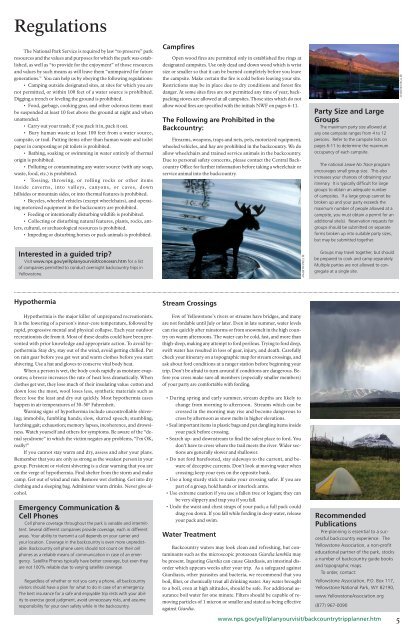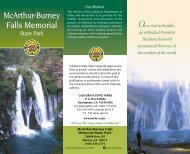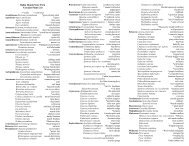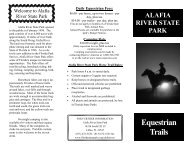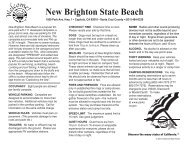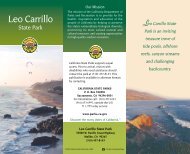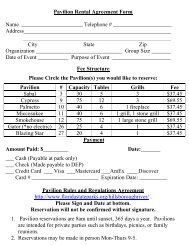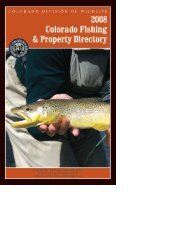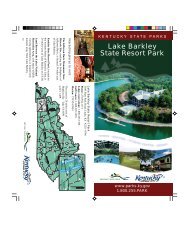Backcountry Trip Planner
Backcountry Trip Planner
Backcountry Trip Planner
- No tags were found...
You also want an ePaper? Increase the reach of your titles
YUMPU automatically turns print PDFs into web optimized ePapers that Google loves.
RegulationsThe National Park Service is required by law “to preserve” parkresources and the values and purposes for which the park was established,as well as “to provide for the enjoyment” of those resourcesand values by such means as will leave them “unimpaired for futuregenerations.” You can help us by obeying the following regulations:• Camping outside designated sites, at sites for which you arenot permitted, or within 100 feet of a water source is prohibited.Digging a trench or leveling the ground is prohibited.• Food, garbage, cooking gear, and other odorous items mustbe suspended at least 10 feet above the ground at night and whenunattended.• Carry out your trash; if you pack it in, pack it out.• Bury human waste at least 100 feet from a water source,campsite, or trail. Putting items other than human waste and toiletpaper in composting or pit toilets is prohibited.• Bathing, soaking or swimming in water entirely of thermalorigin is prohibited.• Polluting or contaminating any water source (with any soap,waste, food, etc.) is prohibited.• Tossing, throwing, or rolling rocks or other itemsinside caverns, into valleys, canyons, or caves, downhillsides or mountain sides, or into thermal features is prohibited.• Bicycles, wheeled vehicles (except wheelchairs), and operatingmotorized equipment in the backcountry are prohibited.• Feeding or intentionally disturbing wildlife is prohibited.• Collecting or disturbing natural features, plants, rocks, antlers,cultural, or archaeological resources is prohibited.• Impeding or disturbing horses or pack animals is prohibited.CampfiresOpen wood fires are permitted only in established fire rings atdesignated campsites. Use only dead and down wood which is wristsize or smaller so that it can be burned completely before you leavethe campsite. Make certain the fire is cold before leaving your site.Restrictions may be in place due to dry conditions and forest firedanger. At some sites fires are not permitted any time of year; backpackingstoves are allowed at all campsites. Those sites which do notallow wood fires are specified with the initials NWF on pages 6–11.The Following are Prohibited in the<strong>Backcountry</strong>:Firearms, weapons, traps and nets, pets, motorized equipment,wheeled vehicles, and hay are prohibited in the backcountry. We doallow wheelchairs and trained service animals in the backcountry.Due to personal safety concerns, please contact the Central <strong>Backcountry</strong>Office for further information before taking a wheelchair orservice animal into the backcountry.Party Size and LargeGroupsThe maximum party size allowed atany one campsite ranges from 4 to 12persons. Refer to the campsite lists onpages 6-11 to determine the maximumoccupancy of each campsite.The national Leave No Trace programencourages small group size. This alsoincreases your chances of obtaining youritinerary. It is typically difficult for largegroups to obtain an adequate numberof campsites. If a large group cannot bebroken up and your party exceeds themaximum number of people allowed at acampsite, you must obtain a permit for anadditional site(s). Reservation requests forgroups should be submitted on separateforms broken up into suitable party sizes,but may be submitted together.© TOM MURPHYInterested in a guided trip?Visit www.nps.gov/yell/planyourvisit/concessn.htm for a listof companies permitted to conduct overnight backcountry trips inYellowstone.© TOM MURPHYGroups may travel together, but shouldbe prepared to cook and camp separately.Multiple parties are not allowed to congregateat a single site........................................................................................................................................................................................................................................................................................................................HypothermiaStream CrossingsHypothermia is the major killer of unprepared recreationists.It is the lowering of a person’s inner-core temperature, followed byrapid, progressive mental and physical collapse. Each year outdoorrecreationists die from it. Most of these deaths could have been preventedwith prior knowledge and appropriate action. To avoid hypothermia:Stay dry, stay out of the wind, avoid getting chilled. Puton rain gear before you get wet and warm clothes before you startshivering. Use a hat and gloves to conserve vital body heat.When a person is wet, the body cools rapidly as moisture evaporates;a breeze increases the rate of heat loss dramatically. Whenclothes get wet, they lose much of their insulating value: cotton anddown lose the most, wool loses less, synthetic materials such asfleece lose the least and dry out quickly. Most hypothermia caseshappen in air temperatures of 30–50° Fahrenheit.Warning signs of hypothermia include uncontrollable shivering;immobile, fumbling hands; slow, slurred speech; stumbling,lurching gait; exhaustion; memory lapses, incoherence, and drowsiness.Watch yourself and others for symptoms. Be aware of the “denialsyndrome” in which the victim negates any problems, “I’m OK,really!”If you cannot stay warm and dry, assess and alter your plans.Remember that you are only as strong as the weakest person in yourgroup. Persistent or violent shivering is a clear warning that you areon the verge of hypothermia. Find shelter from the storm and makecamp. Get out of wind and rain. Remove wet clothing. Get into dryclothing and a sleeping bag. Administer warm drinks. Never give alcohol.Emergency Communication &Cell PhonesCell phone coverage throughout the park is variable and intermittent.Several different companies provide coverage, each in differentareas. Your ability to transmit a call depends on your carrier andyour location. Coverage in the backcountry is even more unpredictable.<strong>Backcountry</strong> cell phone users should not count on their cellphones as a reliable means of communication in case of an emergency.Satellite Phones typically have better coverage, but even theyare not 100% reliable due to varying satellite coverage.Regardless of whether or not you carry a phone, all backcountryvisitors should have a plan for what to do in case of an emergency.The best insurance for a safe and enjoyable trip rests with your abilityto exercise good judgment, avoid unnecessary risks, and assumeresponsibility for your own safety while in the backcountry.Few of Yellowstone’s rivers or streams have bridges, and manyare not fordable until July or later. Even in late summer, water levelscan rise quickly after rainstorms or from snowmelt in the high countryon warm afternoons. The water can be cold, fast, and more thanthigh-deep, making any attempt to ford perilous. Trying to ford deep,swift water has resulted in loss of gear, injury, and death. Carefullycheck your itinerary on a topographic map for stream crossings, andask about ford conditions at a ranger station before beginning yourtrip. Don’t be afraid to turn around if conditions are dangerous. Beforeyou cross make sure all members (especially smaller members)of your party are comfortable with fording.• During spring and early summer, stream depths are likely tochange from morning to afternoon. Streams which can becrossed in the morning may rise and become dangerous tocross by afternoon as snow melts in higher elevations.• Seal important items in plastic bags and put dangling items insideyour pack before crossing.• Search up- and downstream to find the safest place to ford. Youdon’t have to cross where the trail meets the river. Wider sectionsare generally slower and shallower.• Do not ford barefooted, stay sideways to the current, and bewareof deceptive currents. Don’t look at moving water whencrossing; keep your eyes on the opposite bank.• Use a long sturdy stick to make your crossing safer. If you arepart of a group, hold hands or interlock arms.• Use extreme caution if you use a fallen tree or logjam; they canbe very slippery and trap you if you fall.• Undo the waist and chest straps of your pack; a full pack coulddrag you down. If you fall while fording in deep water, releaseyour pack and swim.Water Treatment<strong>Backcountry</strong> waters may look clean and refreshing, but contaminantssuch as the microscopic protozoan Giardia lamblia maybe present. Ingesting Giardia can cause Giardiasis, an intestinal disorderwhich appears weeks after your trip. As a safeguard againstGiardiasis, other parasites and bacteria, we recommend that youboil, filter, or chemically treat all drinking water. Any water broughtto a boil, even at high altitudes, should be safe. For additional assuranceboil water for one minute. Filters should be capable of removingparticles of 1 micron or smaller and stated as being effectiveagainst Giardia.RecommendedPublicationsPre-planning is essential to a successfulbackcountry experience. TheYellowstone Association, a non-profiteducational partner of the park, stocksa number of backcountry guide booksand topographic maps.To order, contact:Yellowstone Association, P.O. Box 117,Yellowstone National Park, WY 82190,www.YellowstoneAssociation.org(877) 967-0090www.nps.gov/yell/planyourvisit/backcountrytripplanner.htm5


